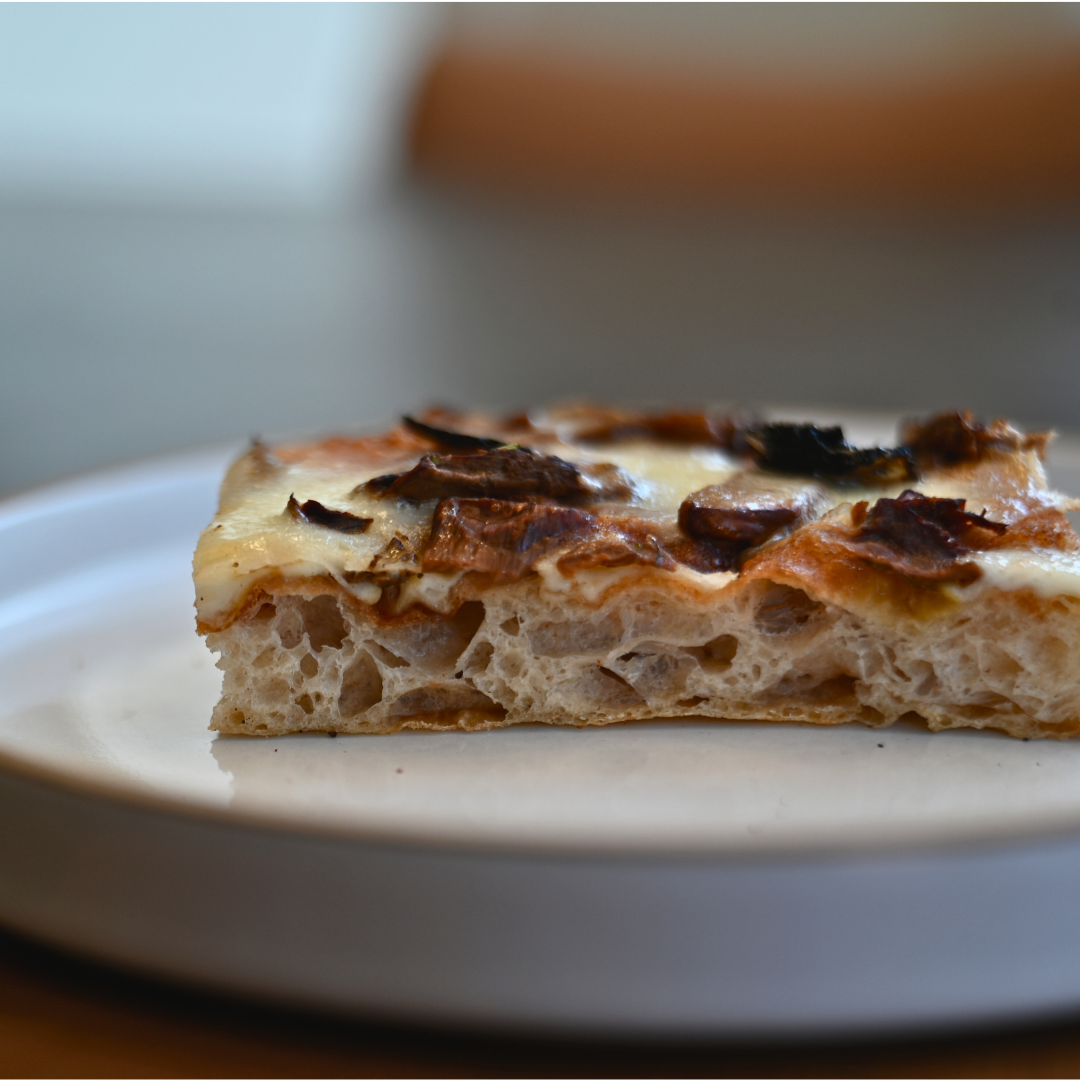
Roman-style Pizza in Teglia (Pan Pizza) recipe with Biga preferment
|
|
Time to read 4 min
|
|
|
Time to read 4 min
|

24 hours
12 min
2 large pan pizzas (24"x16")
Pizza, Focaccia, Bread
Rome, Italy
Far less known in the US than other styles (such as Neapolitan or NY style), Roman-style Pizza in Teglia might be the most underrated pizza style out there. Crunchy and crispy on the outside, soft on the inside, and so much room for toppings- this pizza has it all and is one of our family favorites. 🍕
Incredibly popular in Italy, and Rome in particular- Roman-style Pizza in Teglia (Pan Pizza) is known for its light, airy crumb and wonderfully crispy crust. Walk the streets of the Eternal city, and you'll find many small shops specializing in this delicious style of pizza.
But what's the secret to achieving this unparalleled texture and depth of flavor at home? The answer lies in the Biga preferment .
This comprehensive recipe will guide you through crafting a truly exceptional Roman-style pan pizza, starting with a traditional Biga . This stiff, Italian pre-ferment works wonders, enhancing the dough's strength, digestibility, and creating those signature large, open air pockets that make Pizza in Teglia so irresistible.
This roman-style pizza in teglia only requires 5 ingredients:
The flour and water are divided as follows:
The day before baking your pizza, prepare a biga preferment by dissolving the yeast in water, then combining the flour and water/yeast mixture.
Make sure all flour is incorporated and that there are no clumps in the biga. Break down the biga in small pieces to ensure it can rest without rising.
We will write a separate article on how to make biga. At this point, it's critical that the biga has a final temperature not above 18-20C (65-68F) and that it is only slightly mixed. Gluten should not be allowed to be formed at this stage.
The biga should then be left to rest for about 16-24 hours at 16C/60F.
Break the biga into small pieces (this helps ensure there are no clumps in the mixed dough), then place it together with the rest of the flour and half of the remaining water in a bowl (we use a spiral mixer).
Once the flour and water are incorporated, slowly work in the rest of the water. Mix as gently as possible, only increasing speed if necessary.
Add the salt with the last bit of water, then add the olive oil. The dough should have well developed gluten at this stage.
When you are done mixing, let the dough rest for 5 minutes, then flip it on the counter and shape it into a ball.
Balancing extensibility and elasticity is crucial to achieving the right consistency for roman-style pizza in teglia.
To prevent the dough from becoming too tense and elastic, we run a relatively short first rise, letting the dough only rise up to about 50-75%. For us, it took about 2-2.5 hours at room temperature.
Once the dough has risen approximately 50% to maximum 75%, it's ready to be preshaped.
We divided our dough into two, then gently shaped each dough in a oval ball, being careful to not shape it too tightly, so it could keep the right extensibility needed for the next phase of stretching.
At room temperature, the final rise will take about 2-2.5 hours. The dough can also be put in the fridge for a longer cold proof, if preferred.
Once the final proofing is complete, the dough is ready to be stretched on the teglia (pan). We recommend using a blue steel pan which tends to transfer heat to the pan extremely well.
Flip the dough on the counter, dusted in generous semolina flour, then lightly pat it and transfer it to your blue steel pizza pan. Once positioned, gently stretch it to reach the corners of the pan, filling the pan with an even layer of dough. Be as gently as possible to avoid degassing the dough.
If the dough proofed correctly, it should be elastic and stretch easily without springing back excessively, and without breaking down as it stretches.
Baking correctly is extremely important to achieving the perfect balance between a soft interior and crunchy, thin crust.
Roman-style pizza in teglia is baked in two phases: first, bake the pizza without toppings (just tomato sauce, or olive oil) for about 7-8 minutes at 290-300C (550-575F).
After this first bake, remove the pizza from the oven and let it cool for a few minutes on a cooling rack.
Then, proceed to top the pizza, and run the final bake. This second bake takes approximately 3-4 minutes at 250-275C (500-525F). This second bake will create a really crunch, crispy exterior.
This pizza can bake well in a home oven, just make sure to turn up the oven to the highest available temperature.


